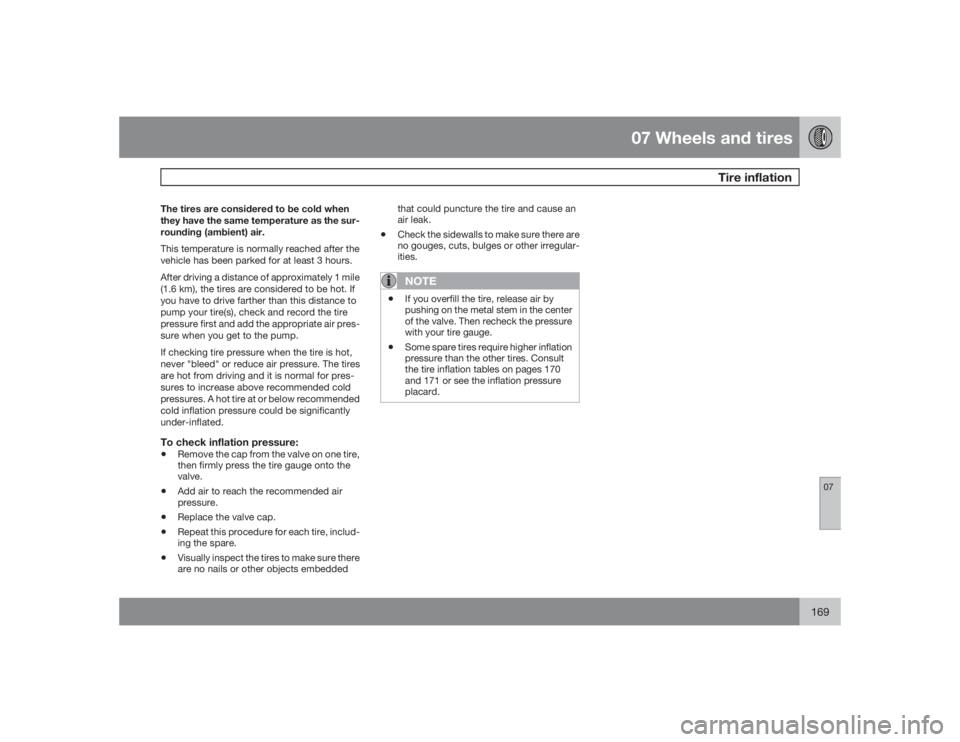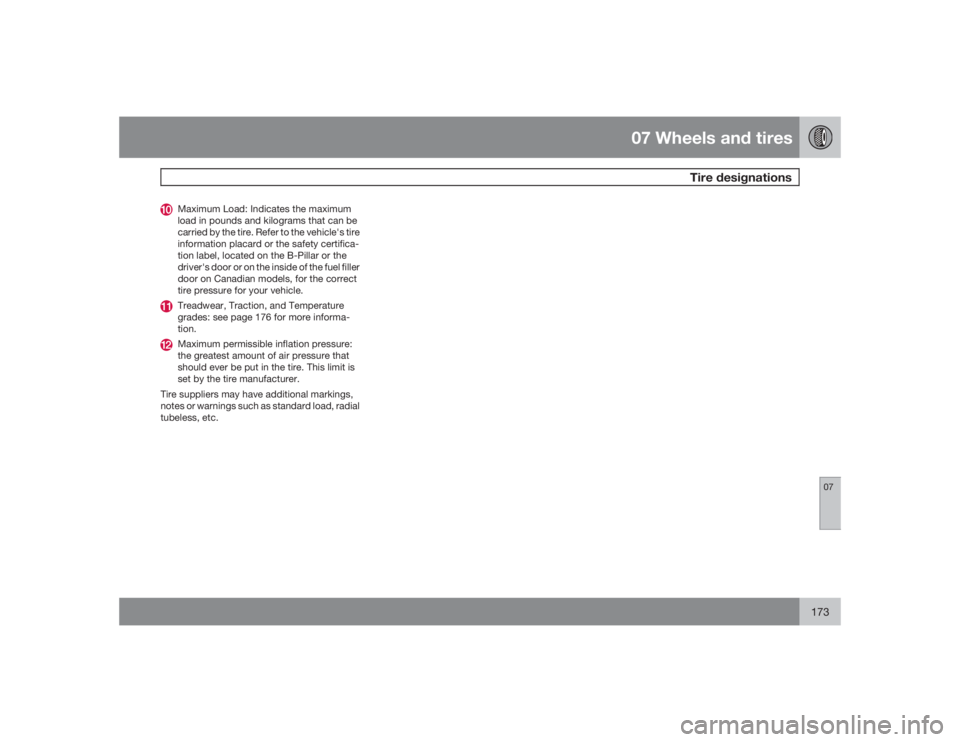2009 VOLVO XC90 flat tire
[x] Cancel search: flat tirePage 164 of 282

G020918
164
General information............................................................................... 166
Tire inflation .......................................................................................... 168
Tire inflation pressure tables – U.S. models......................................... 170
Tire inflation pressure tables – Canadian models................................. 171
Tire designations................................................................................... 172
Glossary of tire terminology.................................................................. 174
Vehicle loading...................................................................................... 175
Uniform Tire Quality Grading................................................................ 176
Snow chains, snow tires, studded tires................................................ 177
Temporary spare................................................................................... 178
Tire rotation........................................................................................... 179
Changing wheels................................................................................... 180
Tire Sealing System ............................................................................. 185
Tire Pressure Monitoring System (TPMS) – U.S. models only.............. 190
Page 167 of 282

07 Wheels and tires
General information
07
167
WARNING
•
The wheel and tire sizes for your Volvo
are specified to meet stringent stability
and handling requirements. Unap-
proved wheel/tire size combinations
can negatively affect your vehicle's sta-
bility and handling. Approved tire sizes
are shown in the Tire inflation pressure
tables on pages 170 and 171.
•
Any damage caused by installation of
unapproved wheel/tire size combina-
tions will not be covered by your new
vehicle warranty. Volvo assumes no
responsibility for death, injury, or
expenses that may result from such
installations.
New tires
Remember that tires are per-
ishable goods. As of 2000, the
manufacturing week and year
will be indicated with 4 digits
(e.g. 1502 means that the tire
illustrated was manufactured
during week 15 of 2002).
Tire ageTires degrade over time, even when they are
not being used. It is recommended that tires
generally be replaced after 6 years of normal
service. Heat caused by hot climates, frequent
high loading conditions or Ultra Violet (U.V)
exposure can accelerate the aging process.
You should replace the spare tire when you
replace the other road tires due to the aging of
the spare.
A tire's age can be determined by the DOT
stamp on the sidewall (see the illustration
above).
A tire with e.g., visible cracks or discoloration
should be replaced immediately.Improving tire economy: •
Maintain correct tire pressure. See the tire
pressure table see page 170.
•
Drive smoothly: avoid fast starts, hard
braking and tire screeching.
•
Tire wear increases with speed.
•
Correct front wheel alignment is very
important.
•
Unbalanced wheels impair tire economy
and driving comfort.
•
Tires must maintain the same direction of
rotation throughout their lifetime.When replacing tires, the tires with the most
tread should be mounted on the rear wheels to
reduce the chance of oversteer during hard
braking.
Hitting curbs or potholes can damage the tires
and/or wheels permanently.
Page 168 of 282

07 Wheels and tiresTire inflation
07168
G032513
Tire inflation placards on U.S. modelsCheck tire inflation pressure regularly.
Tables listing the recommended inflation pres-
sure for your vehicle can be found on pages
170 and 171. A tire inflation pressure placard
is also located on the driver's side B-pillar (the
structural member at the side of the vehicle, at
the rear of the driver's door opening). This plac-
ard indicates the designation of the factory-
mounted tires on your vehicle, as well as load
limits and inflation pressure.
G032520
Tire inflation placard on Canadian models
NOTE
The placards shown indicate inflation pres-
sure for the tires installed on the vehicle at
the factory only.•
Use a tire gauge to check the tire inflation
pressure, including the spare, at least once
a month and before long trips. You are
strongly urged to buy a reliable tire pres-
sure gauge, as automatic service station
gauges may be inaccurate.
•
Use the recommended cold inflation pres-
sure for optimum tire performance and
wear.
•
Under-inflation or over-inflation may cause
uneven treadwear patterns.WARNING
•
Under-inflation is the most common
cause of tire failure and may result in
severe tire cracking, tread separation,
or "blow-out," with unexpected loss of
vehicle control and increased risk of
injury.
•
Under-inflated tires reduce the load car-
rying capacity of your vehicle.
When weather temperature changes occur, tire
inflation pressures also change. A 10-degree
temperature drop causes a corresponding
drop of 1 psi (7 kPa) in inflation pressure. Check
your tire pressures frequently and adjust them
to the proper pressure, which can be found on
the vehicle's tire information placard or certifi-
cation label.Checking tire pressureA certain amount of air seepage from the tires
occurs naturally and tire pressure fluctuates
with seasonal changes in temperature. Always
check tire pressure regularly.Cold tiresInflation pressure should be checked when the
tires are cold.
Page 169 of 282

07 Wheels and tires
Tire inflation
07
169
The tires are considered to be cold when
they have the same temperature as the sur-
rounding (ambient) air.
This temperature is normally reached after the
vehicle has been parked for at least 3 hours.
After driving a distance of approximately 1 mile
(1.6 km), the tires are considered to be hot. If
you have to drive farther than this distance to
pump your tire(s), check and record the tire
pressure first and add the appropriate air pres-
sure when you get to the pump.
If checking tire pressure when the tire is hot,
never "bleed" or reduce air pressure. The tires
are hot from driving and it is normal for pres-
sures to increase above recommended cold
pressures. A hot tire at or below recommended
cold inflation pressure could be significantly
under-inflated.To check inflation pressure:•
Remove the cap from the valve on one tire,
then firmly press the tire gauge onto the
valve.
•
Add air to reach the recommended air
pressure.
•
Replace the valve cap.
•
Repeat this procedure for each tire, includ-
ing the spare.
•
Visually inspect the tires to make sure there
are no nails or other objects embeddedthat could puncture the tire and cause an
air leak.
•
Check the sidewalls to make sure there are
no gouges, cuts, bulges or other irregular-
ities.NOTE
•
If you overfill the tire, release air by
pushing on the metal stem in the center
of the valve. Then recheck the pressure
with your tire gauge.
•
Some spare tires require higher inflation
pressure than the other tires. Consult
the tire inflation tables on pages 170
and 171 or see the inflation pressure
placard.
Page 170 of 282

07 Wheels and tiresTire inflation pressure tables – U.S. models
07170
The following tire pressures are recommended
by Volvo for your vehicle. Refer to the tire infla-
tion placard for information specific to the tires
installed on your vehicle at the factory.Cold tire pressures up to five per-
sonsTire size
Front, psi
(kPa)
Rear, psi
(kPa)
XC90
225/70R16
235/65R17
235/60R18
255/50R19
255/45R20
36 (250)
36 (250)
Temporary
spare tire
T155/85R18
61 (420)
61 (420)
Load ratingsThe load ratings on the tire's sidewall translate
as follows, for example:
102 = 1874 lbs (850 kg)
104 = 1984 lbs (900 kg)
107 = 2150 lbs (975 kg)
Speed ratingsThe speed ratings on the tire's sidewall trans-
late as follows, for example:
M = 81 mph (130 km/h)
H = 130 mph (210 km/h)
V = 149 mph (240 km/h)
Y = 186 mph (300 km/h)
See also page 172 for an explanation of the
designations on the sidewall of the tire.
Page 171 of 282

07 Wheels and tires
Tire inflation pressure tables – Canadian models
07
171
The following tire pressures are recommended
by Volvo for your vehicle. Refer to the tire infla-tion placard for information specific to the tires
installed on your vehicle at the factory.Cold tire pressures up to five personsTire size
Cold tire pressures up to five persons psi (kPa)
Optional pressure up to three persons psi (kPa)
Front
Rear
Front
Rear
225/70R16
235/65R17
235/60R18
39 (270)
39 (270)
32 (220)
32 (220)
255/50R19
255/45R20
39 (270)
39 (270)
35 (240)
35 (240)
Temporary spare tire
T155/85R18
61 (420)
61 (420)
61 (420)
61 (420)
Page 172 of 282

07 Wheels and tiresTire designations
07172
123456
1211108
7
9
G026442
Federal law mandates that tire manufacturers
place standardized information on the sidewall
of all tires (see the illustration).
The following information is listed on the tire
sidewall:
The tire designation (the following figures are
examples of a tire designation):
215: the width of the tire (in millimeters)
from sidewall edge to sidewall edge. The
larger the number, the wider the tire.65: The ratio of the tire's height to its width.R: Radial tire.15: The diameter of the wheel rim (in
inches).
95: The tire's load index. In this example, a
load index of 95 equals a maximum load of
1521 lbs (690 kg).H: The tire's speed rating, or the maximum
speed at which the tire is designed to be
driven for extended periods of time, carry-
ing a permissible load for the vehicle, and
with correct inflation pressure. For exam-
ple, H indicates a speed rating of 130 mph
(210 km/h).NOTE
This information may not appear on the tire
because it is not required by law.
M+S or M/S = Mud and Snow; AT = All
Terrain;AS = All SeasonU.S. DOT Tire Identification Number (TIN):
This begins with the letters "DOT" and indi-
cates that the tire meets all federal stand-
ards. The next two numbers or letters are
the plant code where it was manufactured,
the next two are the tire size code and the
last four numbers represent the week and
year the tire was built. For example, the
numbers 317 mean the 31st week of 1997.
After 2000 the numbers go to four digits.
For example, 2501 means the 25th week of
2001. The numbers in between are mar-
keting codes used at the manufacturer's
discretion. This information helps a tire
manufacturer identify a tire for safety recall
purposes.Tire Ply Composition and Material Used:
Indicates the number of plies indicates or
the number of layers of rubber-coated fab-
ric in the tire tread and sidewall. Tire man-
ufacturers also must indicate the ply mate-
rials in the tire and the sidewall, which
include steel, nylon, polyester, and others.
Page 173 of 282

07 Wheels and tires
Tire designations
07
173
Maximum Load: Indicates the maximum
load in pounds and kilograms that can be
carried by the tire. Refer to the vehicle's tire
information placard or the safety certifica-
tion label, located on the B-Pillar or the
driver's door or on the inside of the fuel filler
door on Canadian models, for the correct
tire pressure for your vehicle.Treadwear, Traction, and Temperature
grades: see page 176 for more informa-
tion.Maximum permissible inflation pressure:
the greatest amount of air pressure that
should ever be put in the tire. This limit is
set by the tire manufacturer.
Tire suppliers may have additional markings,
notes or warnings such as standard load, radial
tubeless, etc.